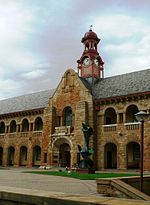
Pretoria, also known as Tshwane, is one of South Africa’s three capital cities, serving as the seat of the executive branch of government, and as the host to all foreign embassies to South Africa.
HF, Hf or hf can refer to:

Hendrik Frensch Verwoerd, also commonly referred to as Dr. Verwoerd, was a South African politician, a scholar of applied psychology and sociology, and a journalist. Verwoerd played an instrumental role in socially engineering apartheid, the country's system of institutionalized racial segregation and white supremacy, and implementing its policies as Minister of Native Affairs (1950–1958) and then prime minister (1958–1966). Furthermore, he played a vital role in helping the far-right National Party come to power in 1948, serving as their political strategist and propagandist, becoming party leader upon his premiership. He was the Union of South Africa's last prime minister, from 1958 to 1961, when he proclaimed the founding of the Republic of South Africa, remaining its prime minister until his assassination in 1966.
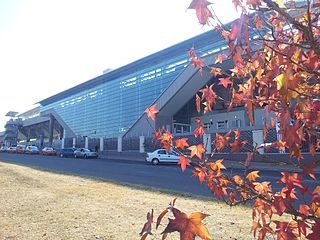
Centurion is a town with 236,580 (2011 Census) inhabitants in the Gauteng Province of South Africa, located between Pretoria and Midrand (Johannesburg). Formerly an independent municipality, with its own town council, it has formed part of the City of Tshwane Metropolitan Municipality since 2000. Its heart is located at the intersection of the N1 and N14 freeways. The R21 also passes through Centurion.
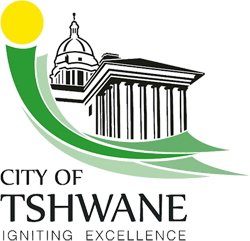
The City of Tshwane Metropolitan Municipality is the metropolitan municipality that forms the local government of northern Gauteng Province, South Africa. The Metropolitan area is centred on the city of Pretoria with surrounding towns and localities included in the local government area.

Mamphela Aletta Ramphele is a South African politician, an activist against apartheid, a medical doctor, an academic and businesswoman. She was a partner of anti-apartheid activist Steve Biko, with whom she had two children. She is a former Vice-Chancellor at the University of Cape Town and a one-time Managing Director at the World Bank. Ramphele founded political party Agang South Africa in February 2013 and withdrew from politics in July 2014.

Thaba Tshwane is a military base, in Pretoria, South Africa.

The Bantu Education Act, 1953 was a South African segregation law which legalised several aspects of the apartheid system. Its major provision was enforcing racially separated educational facilities. Even universities were made "tribal", and all but three missionary schools chose to close down when the government would no longer help support their schools. Very few authorities continued using their own finances to support education for native Africans. In 1959, this type of education was extended to "non-white" universities and colleges with the Extension of University Education Act, and the University College of Fort Hare was taken over by the government and degraded to being part of the Bantu education system. It is often argued that the policy of Bantu (African) education was aimed to direct black or non-white youth to the unskilled labour market, although Hendrik Verwoerd, at the time Minister of Native Affairs, claimed that the aim was to solve South Africa's "ethnic problems" by creating complementary economic and political units for different ethnic groups.
Tshwane District Hospital is situated in Prinshof 349-Jr, a suburb of Pretoria, South Africa. It was known as H. F. Verwoerd Hospital until 1994, but is now a separate community hospital that deals with non-critical care.

The University of Pretoria is a multi-campus public research university in Pretoria, the administrative and de facto capital of South Africa. The university was established in 1908 as the Pretoria campus of the Johannesburg-based Transvaal University College and is the fourth South African institution in continuous operation to be awarded university status. The university has grown from the original 32 students in a single late Victorian house to approximately 53,000 in 2019. The University was built on 7 suburban campuses on 1,190 hectares.
AfriForum is a South African non-governmental organisation focused mainly on the interests of Afrikaners, a subgroup of the country's white population. AfriForum has been described as a lobby group. It refers to itself as a civil rights group, but it has critically been described as an Afrikaner nationalist group, a white rights group,and a white nationalist group, a description rejected by the organisation's leadership.
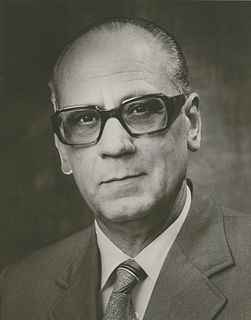
Adriaan Nicolaas Petrus Pelzer was a South African Afrikaans academic, historian, author and Professor at the University of Pretoria, South Africa. He retired as vice rector and acting rector in 1980 from the University of Pretoria. Among books published are the following "The Afrikaner-Broederbond: First 50 Years (1980)" and "Verwoerd Speaks Speeches 1948–1966 (1966)". He was also member of the "National Monuments Council" and in 1978 received the Laureate Award from the University of Pretoria. The Laureate Award is the highest award granted by the University of Pretoria. From 1965 to 1978 he was vice-president and member of the executive committee of Northern-Transvaal Rugby Union, and lifelong member from 1979.
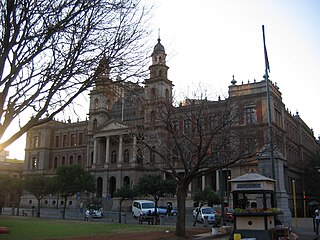
The Palace of Justice forms part of the northern façade of Church Square in Pretoria. The building dates to the nineteenth century and was designed by the Dutch architect Sytze Wierda. It is currently the headquarters of the Gauteng Division of the High Court of South Africa.
The following is a timeline of the history of Pretoria, in the City of Tshwane Metropolitan Municipality, Gauteng province, South Africa.
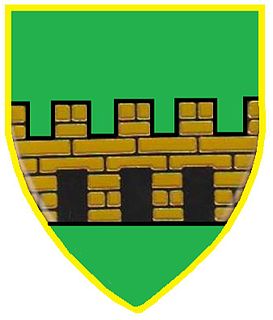
Tshwane Regiment is an infantry regiment of the South African Army. As a reserve unit, it has a status roughly equivalent to that of a British Army Reserve or United States Army National Guard unit.

Capital Park is one of Pretoria's oldest and first suburbs and lies approximately 4 km north of the historic Church Square, behind the Pretoria National Zoo. The neighbourhood is bordered by the Witwatersberge on the south side and the Apies River on the west side. The neighbourhood extends from the Apies River to Voortrekkers Street. Streets in the neighbourhood are named after early mayors of Pretoria. One of the former mayoral residences is in Capital Park. Capital Park was previously a very popular neighbourhood among Italian as well as Portuguese communities - the Portuguese Church is still in Van Heerden Street (2010). The residential area today is cosmopolitan, with predominantly Afrikaans speaking inhabitants. The CPRTA functions as residents' association to look after the interests of its residents.
Zanempilo Community Health Care Centre (ZCHC), infamously known as the "Biko Clinic", was the first primary health care centre initiative outside of the public sector in South Africa. It is located in Zinyoka Village, near King William's Town in the Eastern Cape. The clinic was established as one of the Black Community Programmes (BCPs) spearheaded by Steve Biko and Mamphela Ramphele.
Mashudu Tshifularo is a South African educator and medical specialist. He led the first team in the world to use 3D-printed bones for reconstructive middle ear implants in 2019 at the University of Pretoria and Steve Biko Academic Hospital. As a lay pastor, he has also published several books.














